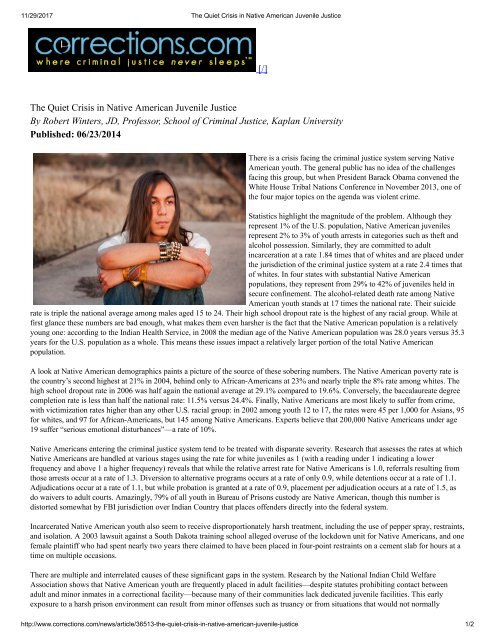Native American Youth In The Juvenile Justice System
Native American Youth In The Juvenile Justice System
Native American Youth In The Juvenile Justice System
You also want an ePaper? Increase the reach of your titles
YUMPU automatically turns print PDFs into web optimized ePapers that Google loves.
11/29/2017 <strong>The</strong> Quiet Crisis in <strong>Native</strong> <strong>American</strong> <strong>Juvenile</strong> <strong>Justice</strong><br />
[/]<br />
<strong>The</strong> Quiet Crisis in <strong>Native</strong> <strong>American</strong> <strong>Juvenile</strong> <strong>Justice</strong><br />
By Robert Winters, JD, Professor, School of Criminal <strong>Justice</strong>, Kaplan University<br />
Published: 06/23/2014<br />
<strong>The</strong>re is a crisis facing the criminal justice system serving <strong>Native</strong><br />
<strong>American</strong> youth. <strong>The</strong> general public has no idea of the challenges<br />
facing this group, but when President Barack Obama convened the<br />
White House Tribal Nations Conference in November 2013, one of<br />
the four major topics on the agenda was violent crime.<br />
Statistics highlight the magnitude of the problem. Although they<br />
represent 1% of the U.S. population, <strong>Native</strong> <strong>American</strong> juveniles<br />
represent 2% to 3% of youth arrests in categories such as theft and<br />
alcohol possession. Similarly, they are committed to adult<br />
incarceration at a rate 1.84 times that of whites and are placed under<br />
the jurisdiction of the criminal justice system at a rate 2.4 times that<br />
of whites. <strong>In</strong> four states with substantial <strong>Native</strong> <strong>American</strong><br />
populations, they represent from 29% to 42% of juveniles held in<br />
secure confinement. <strong>The</strong> alcohol-related death rate among <strong>Native</strong><br />
<strong>American</strong> youth stands at 17 times the national rate. <strong>The</strong>ir suicide<br />
rate is triple the national average among males aged 15 to 24. <strong>The</strong>ir high school dropout rate is the highest of any racial group. While at<br />
first glance these numbers are bad enough, what makes them even harsher is the fact that the <strong>Native</strong> <strong>American</strong> population is a relatively<br />
young one: according to the <strong>In</strong>dian Health Service, in 2008 the median age of the <strong>Native</strong> <strong>American</strong> population was 28.0 years versus 35.3<br />
years for the U.S. population as a whole. This means these issues impact a relatively larger portion of the total <strong>Native</strong> <strong>American</strong><br />
population.<br />
A look at <strong>Native</strong> <strong>American</strong> demographics paints a picture of the source of these sobering numbers. <strong>The</strong> <strong>Native</strong> <strong>American</strong> poverty rate is<br />
the country’s second highest at 21% in 2004, behind only to African-<strong>American</strong>s at 23% and nearly triple the 8% rate among whites. <strong>The</strong><br />
high school dropout rate in 2006 was half again the national average at 29.1% compared to 19.6%. Conversely, the baccalaureate degree<br />
completion rate is less than half the national rate: 11.5% versus 24.4%. Finally, <strong>Native</strong> <strong>American</strong>s are most likely to suffer from crime,<br />
with victimization rates higher than any other U.S. racial group: in 2002 among youth 12 to 17, the rates were 45 per 1,000 for Asians, 95<br />
for whites, and 97 for African-<strong>American</strong>s, but 145 among <strong>Native</strong> <strong>American</strong>s. Experts believe that 200,000 <strong>Native</strong> <strong>American</strong>s under age<br />
19 suffer “serious emotional disturbances”—a rate of 10%.<br />
<strong>Native</strong> <strong>American</strong>s entering the criminal justice system tend to be treated with disparate severity. Research that assesses the rates at which<br />
<strong>Native</strong> <strong>American</strong>s are handled at various stages using the rate for white juveniles as 1 (with a reading under 1 indicating a lower<br />
frequency and above 1 a higher frequency) reveals that while the relative arrest rate for <strong>Native</strong> <strong>American</strong>s is 1.0, referrals resulting from<br />
those arrests occur at a rate of 1.3. Diversion to alternative programs occurs at a rate of only 0.9, while detentions occur at a rate of 1.1.<br />
Adjudications occur at a rate of 1.1, but while probation is granted at a rate of 0.9, placement per adjudication occurs at a rate of 1.5, as<br />
do waivers to adult courts. Amazingly, 79% of all youth in Bureau of Prisons custody are <strong>Native</strong> <strong>American</strong>, though this number is<br />
distorted somewhat by FBI jurisdiction over <strong>In</strong>dian Country that places offenders directly into the federal system.<br />
<strong>In</strong>carcerated <strong>Native</strong> <strong>American</strong> youth also seem to receive disproportionately harsh treatment, including the use of pepper spray, restraints,<br />
and isolation. A 2003 lawsuit against a South Dakota training school alleged overuse of the lockdown unit for <strong>Native</strong> <strong>American</strong>s, and one<br />
female plaintiff who had spent nearly two years there claimed to have been placed in four-point restraints on a cement slab for hours at a<br />
time on multiple occasions.<br />
<strong>The</strong>re are multiple and interrelated causes of these significant gaps in the system. Research by the National <strong>In</strong>dian Child Welfare<br />
Association shows that <strong>Native</strong> <strong>American</strong> youth are frequently placed in adult facilities—despite statutes prohibiting contact between<br />
adult and minor inmates in a correctional facility—because many of their communities lack dedicated juvenile facilities. This early<br />
exposure to a harsh prison environment can result from minor offenses such as truancy or from situations that would not normally<br />
http://www.corrections.com/news/article/36513-the-quiet-crisis-in-native-american-juvenile-justice 1/2

















